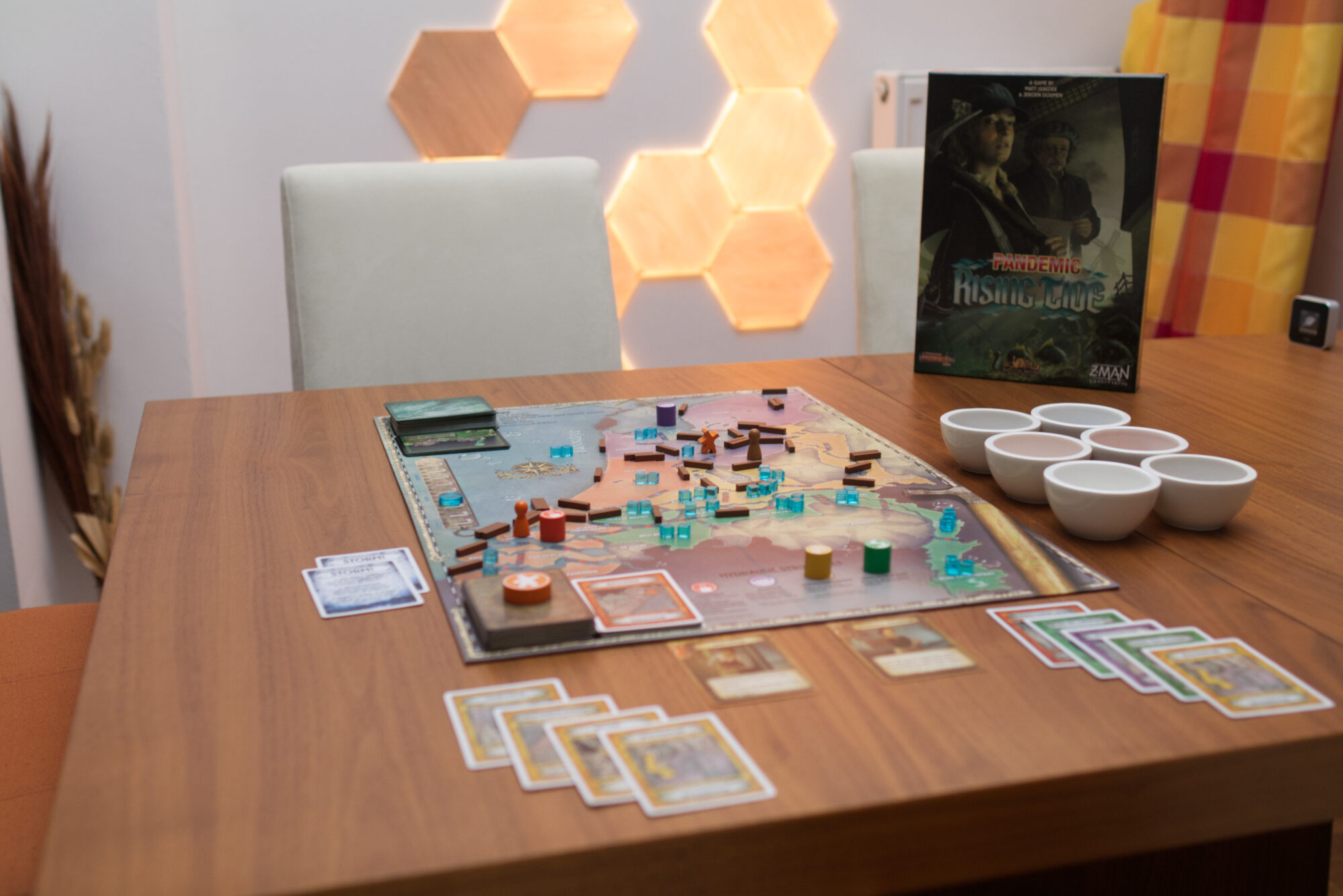After playing the original Pandemic for over ten years, struggling with mutating viruses and terrorists in Pandemic: On the Brink, and upending the usual way to cure things with Pandemic: In the Lab, the prospect of digging into another version of the all to familiar Pandemic seemed daunting to me.
Pandemic has rightfully become a classic of the hobby and can now be found in big box stores that only stocked Monopoly not that long ago. But despite having played through two expansions, I never really enjoyed the core challenge in Pandemic particularly much though. It seemed too same-y for me and so I mostly pulled it off the shelf to introduce new players to it. As a result, I was curious about the various iterations on the system but never really felt the urge to buy one. Still, somehow Rising Tide in particular kept lingering in my head, and it was now finally time to give in …
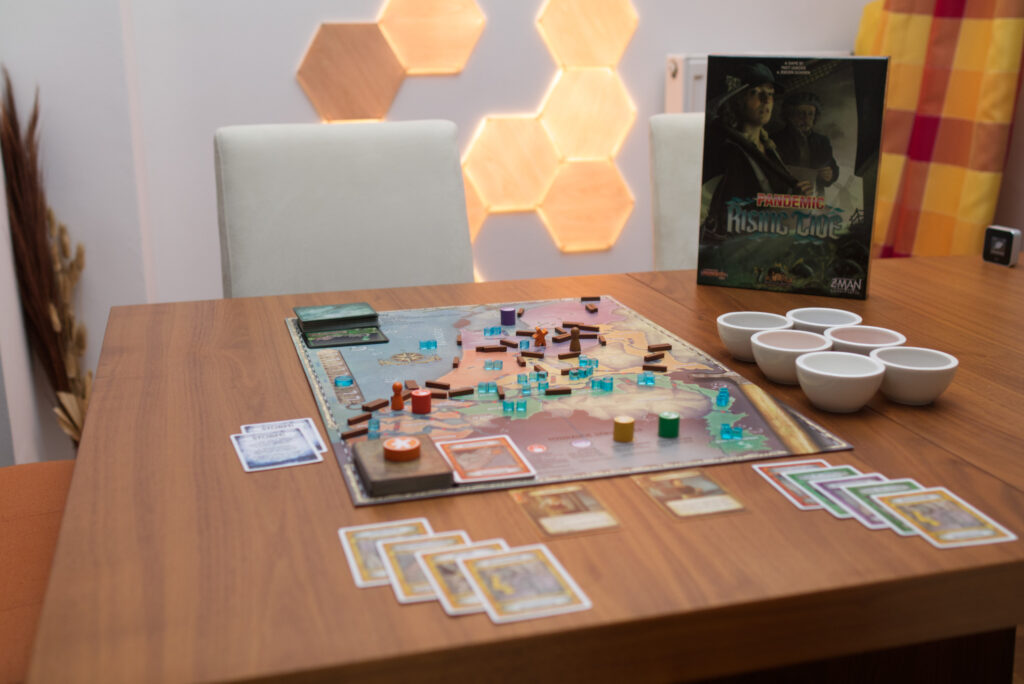
Setup
Compared to standard Pandemic, there is quite a bit of additional setup to do. We’re still choosing the number of cards that at unexpected points during the course of the game ramp up the difficulty (this time called “storm” cards) and for each one take a portion of the draw deck, give it a good shuffle, and then stack the piles on top of each other to form a single combined draw deck for the game. There is also still a second deck of region cards that governs in what regions the situation gets worse each round, with the important modification that now every region is included twice.
The biggest change though is that the board now shows various locations for dikes between neighbouring regions. Most of those locations have a red dot which means on each of those 50 locations a small, brown, wooden stick has to be placed and only a few with blue dots remain without a dike for the start of the game.

Setup then proceeds as normal with causing some initial hazard: 3 sets of 3 region cards are drawn and 3, 2, and then 1 degradations are performed. To degrade a region, one removes any one dike that is on its perimeter. If there is no dike available to be removed, a cube of water is placed instead. So far so simple, although coming from base Pandemic, it took me a bit to focus more on the dikes than on those shiny cubes, as a little bit of water might not be that bad if your defences are in order.
Once the initial degradation is complete, water flows. If there are two cubes of water in a region, all neighboring regions that are not separated by a dike get added a single cube unless they already had one. If a region has three water in it, all adjacent regions not separated by dikes get raised to two cubes water, and those can flood one cube into their neighbours as described before. Also important to note is that the two major sea areas start off as two permanent cubes of water. So if an outer dike is removed, water immediately rushes in at the end of a turn.
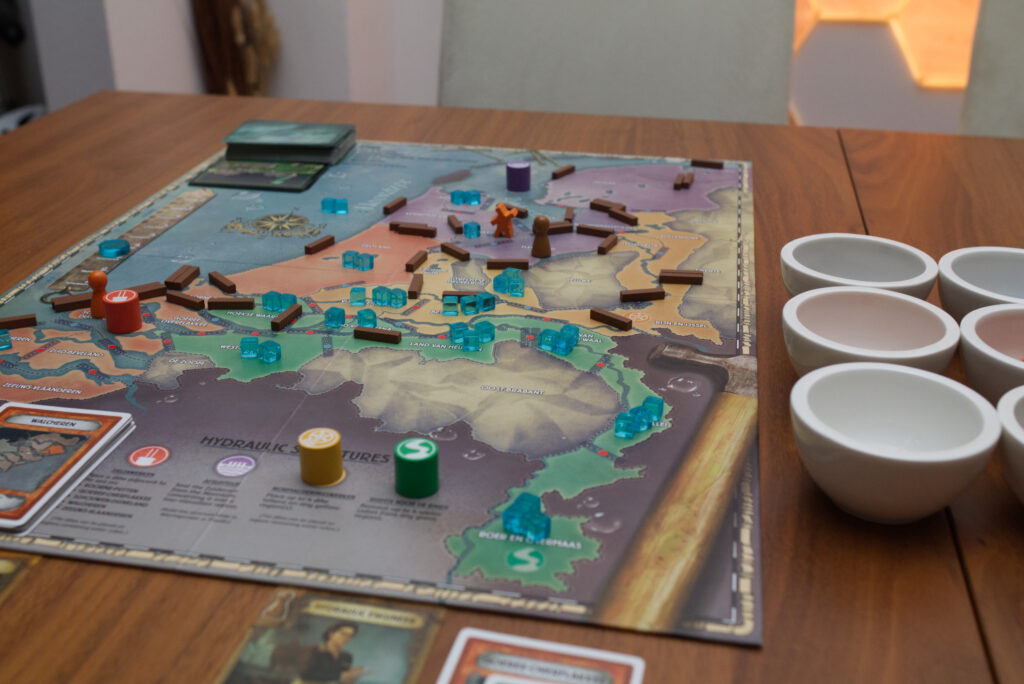
The Turn
The turn structure itself follows the basic Pandemic formula with one key change. Again, the active player has four action points to spent in order to move, remove water cubes, or build infrastructure. A dike can only be built if the player is located in a region with no water in it but crucial one can place more than one dike at the same location, sort of as a backup if the first one fails. It took me a while to internalise this, but of course it saves on travel time if one doesn’t have to rush right back if a single dike is removed.
Ports are similar to the labs of base Pandemic but this time solely act as fast travel points. The most interesting change besides the dike/water-flow mechanism is the introduction of pumps. Each turn, each of the pumps gets activated and will remove one cube of water from the board at no cost. This of course feels amazing, but the challenge is to keep pumps busy as they can only remove water from their own region or any region that is connected to it via other flooded regions. If placed well, a single pump can remove a lot of cubes, if placed badly, the action and card spent to build it while have cost more than it was worth.
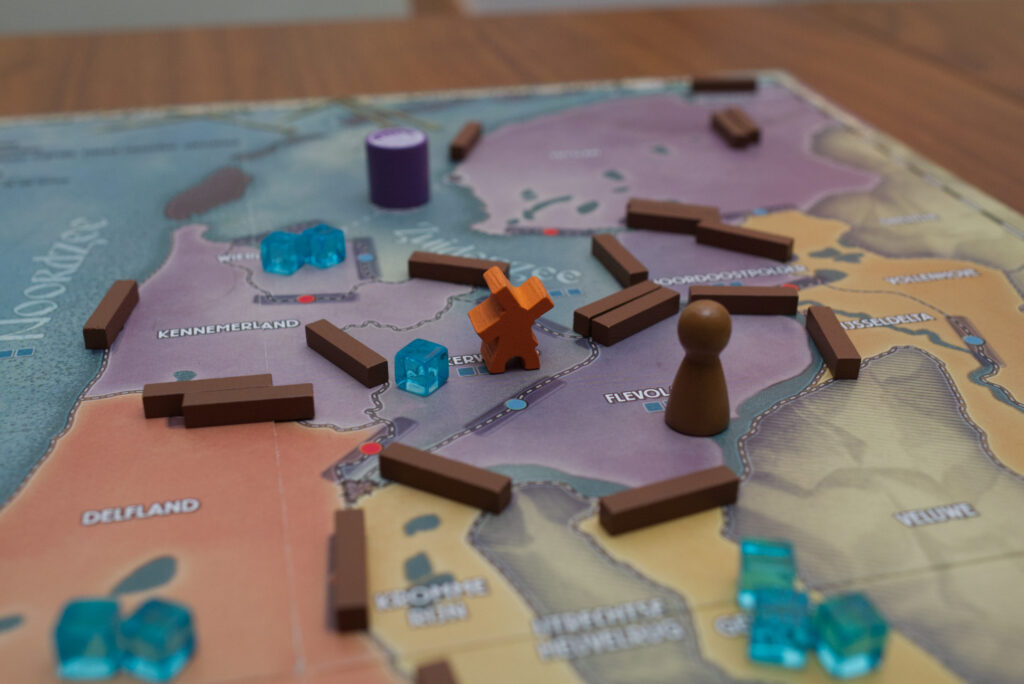
Game End
The ultimate goal of finding cures for diseases has been replaced by building four giant hydraulic structures, one for each of the four coloured parts of the map. As in base Pandemic, this happens by players picking up cards during their turn and once they have collected five of one colour, they can discard those at a specially marked location on the board to build the structure. Quite satisfyingly, each of those structures also comes with a one-time bonus like immediately removing a whole bunch of water or building a large number of dikes for free. The game is won when all four projects are built and lost if the supply of water cubes is ever depleted.
To help prevent this, each player starts of with a unique special power, same as in base pandemic. The bane of the players’ existence are of course those dreaded storm cards that show up at random points in the game and ramp up the sea level and how many region cards need to be drawn when the game fights back each turn.
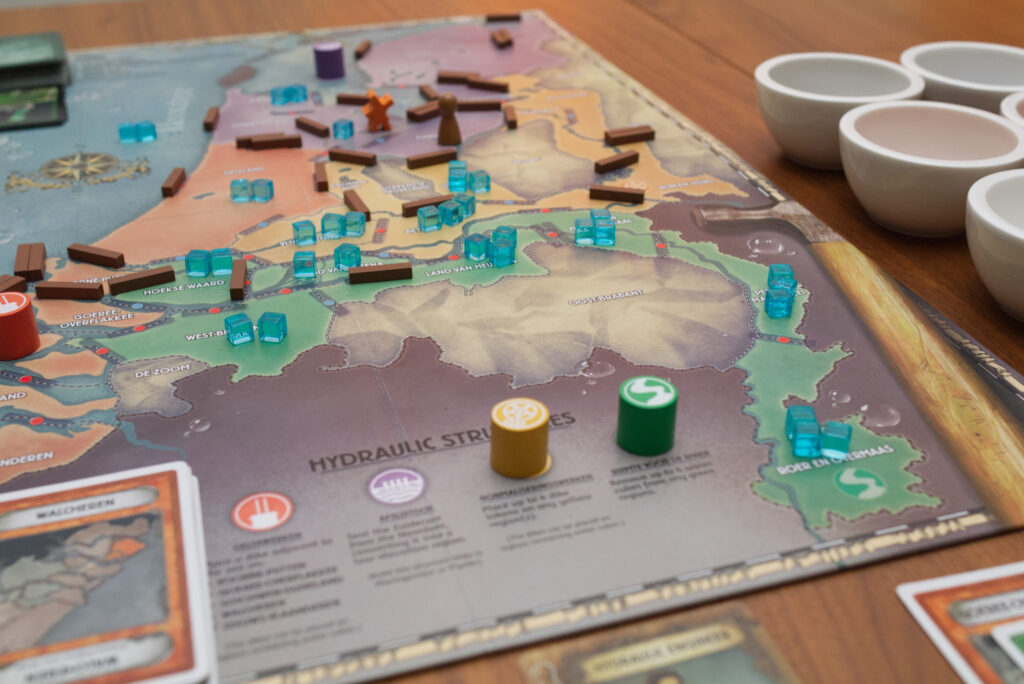
Advanced Goals
In contrast to classic Pandemic, Rising Tide comes with a set of advanced goals and accompanying modules right in the box. To use them, one shuffles the four base goals and advanced cards and draws one per color. There aren’t as many as I had initially thought or hoped, but they still provide a good variety. Note that players are advised to use one less storm card than they normally wood because the advanced goals increase the game’s difficulty quite noticeably. There are population goals which allow players to discard cards to place orange population cubes into regions. If there are ever more than three cubes of water and population combined in the same region, population cubes die until the count is back down to three. If there are too many deaths, instant loss.
Other cards require you to build a lot of ports or pumps, but the nastiest one for me was a red goal that removes a large part of additional dikes during setup. This can have such a big impact that I actually lost twice on the first turn without any chance of combating it. I like a good challenge, but this felt particularly annoying considering how much setup is involved with placing and removing all those dikes. In most situations though, the goals worked as expected. Other goals almost become almost trivial if one has the right player power in play (e.g. building X ports with a player that can build them for free). Overall, it works, but felt a bit too swingy for my taste.
Compared to the standard goals, the advanced goals have the big benefit that one no longer needs to collect a large number of same-colored cards at once and potentially run into hand management problems. On the other hand, the advanced goals can get undone during the game and in order to win, one must manage to fulfil all of them at the same time! Since I’m not a Pandemic-pro, I particularly enjoyed having some of the standard goals and some of the advanced ones in play because I could work on the advanced ones here and there when I had the time and thus clear my hand a bit to collect the cards I needed for those 5-of-a-colour goals.
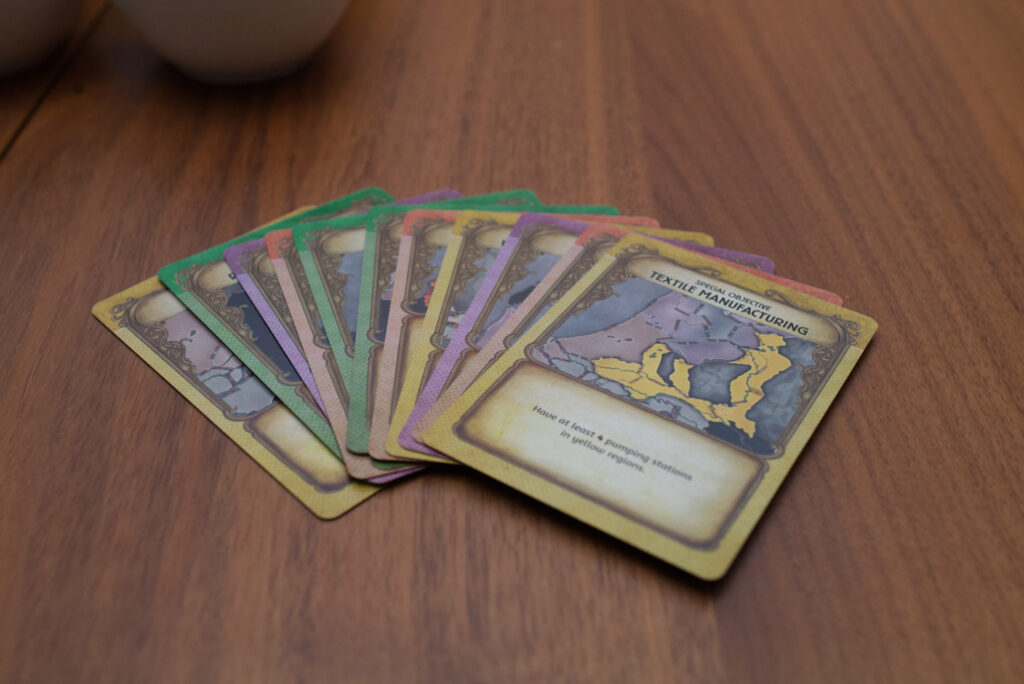
Solo Mode
Well, the short version is: there is none. Pandemic: In the Lab had introduced an official solo mode with an agency the player controls with a special set of rules. But no equivalent exists in Rising Tide. Since this is a co-op game, it’s easy to play two- or three-handed solo though. I usually play with two characters to keep the overhead low and it felt quite satisfying. Of course the usual danger of missing a step in the round structure or accidentally giving the wrong characters new cards exists, but overall Rising Tide works well for solo due to the replayability introduced by the advanced goal cards and the fact that simply more is happening on the board with the pumps and flooding mechanism going on.
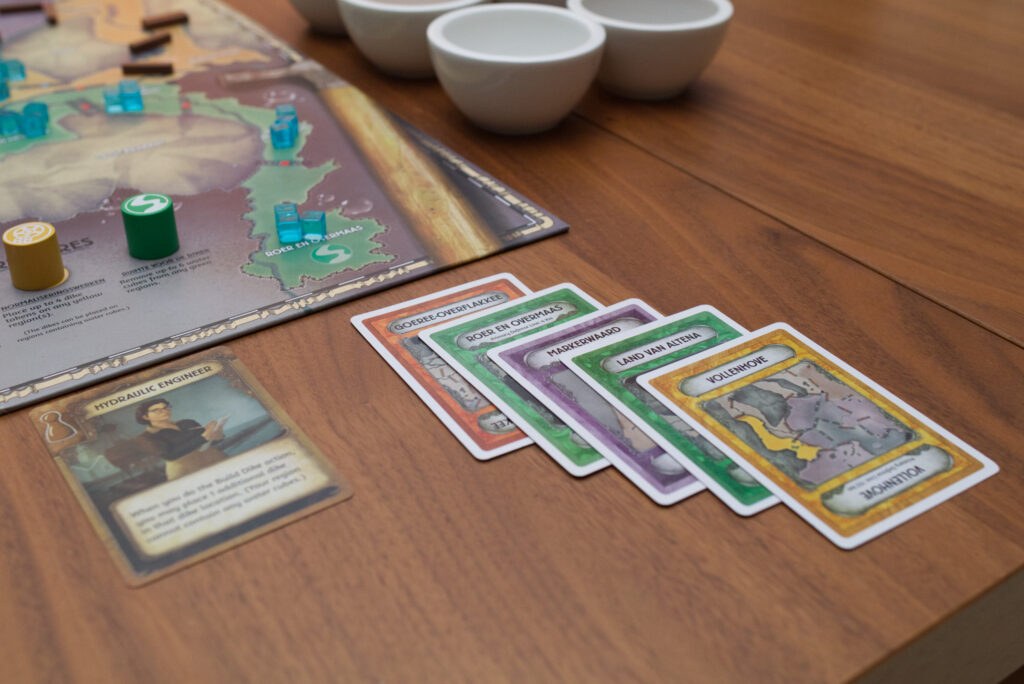
Conclusion
Rising Tide pleasantly surprised me on a number of fronts. After playing base Pandemic for so long, the tried-and-true formula of doing delaying actions while one tries to collect same-coloured cards had little appeal to me. Of course, the mechanism how the destructive region cards are placed back on top of the deck whenever a epidemic card was drawn is still genius, but it has also gotten a little stale by now.
The more I thought about Rising Tide, the more it appeared to me like the two designers (one of them Jeroen from Splotter Spellen fame!) deliberately tried to address every major criticism a modern hobby player could have with regards to base Pandemic. To start, I can much more relate to the topic of saving the Netherlands from the impending flood than I ever could to saving the world from some abstract diseases. This might be because I grew up close to the Netherlands and so this hits closer to home. While it wasn’t next door, I still vividly remember watching TV as a kid and seeing images of large areas being flooded, people climbing on roofs, etc. The new flooding mechanism also ensures a more dynamic gameplay. The game keeps pounding at those dikes and no substantial amounts of water comes in until that one big break and suddenly multiple regions are flooded. It really takes a few plays to no longer focus on the cubes of water but rather where to preventively put dikes.

Integrating the always running pumps adds another elements that Euro-gamers appreciate: a form of investing in something that might pay dividend throughout the rest of the game. However, it’s suitably challenging to build pumps and not have them run dry after only a few runs. So while fun, pumps aren’t overpowered and neither are they something one absolute has to build. I also appreciated that the publisher added a big, screen-printed marker that can be put on top of the draw deck so one doesn’t forget to run the pumps. I still managed to do so while playing solo because I was so in the flow of the game, but when playing multiplayer, it was an effective reminder. In general, this feels like higher production values than base Pandemic.
The end condition of the game also has been improved in multiple ways. For one, since the hydraulic structures come with an instant bonus effect, the gratification of building them is no longer delayed. In base Pandemic, finally being able to create a cure didn’t do much. It made life easier for the rest of the game, but the actual point when one finally got those five cards of the same colour together and managed to reach a laboratory was always a bit anticlimactic. We got that one cure, now what? The other improvement is of course the variability by adding alternate goals. Especially not making them do-them-once-and-forget kind of goals was quite smart. If for example a goal cards says “have no water in the following regions: …”, the players are under constant pressure to keep it so once they have managed to do it. So a big thumbs up on the advanced goals, I just wished there were a few more of them.
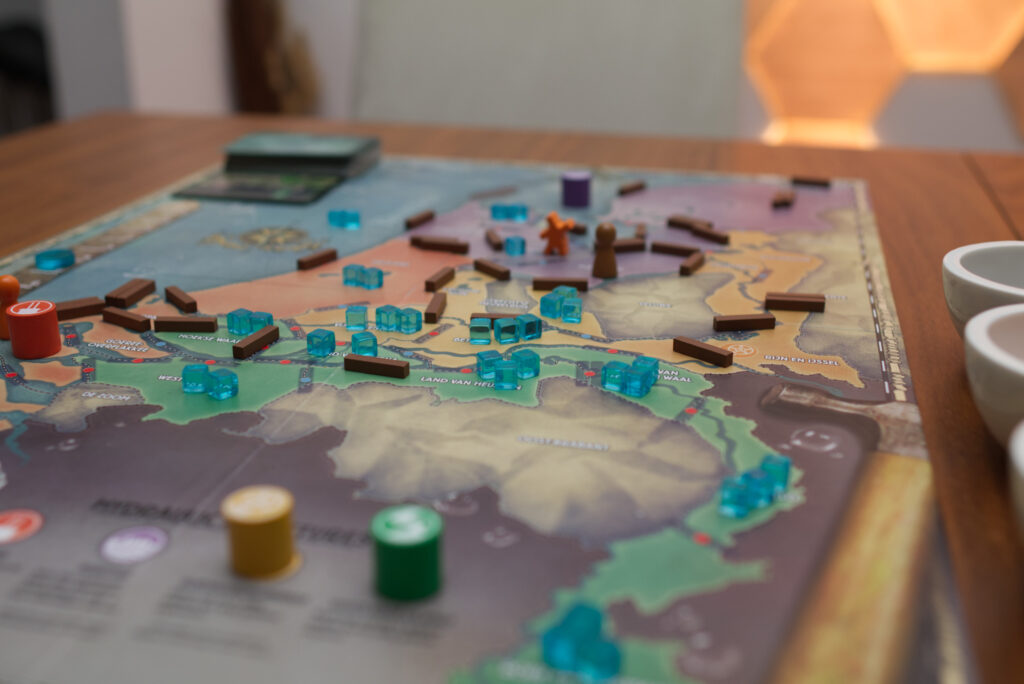
Other tweaks I came to appreciate are for example the high terrain regions which never can get flooded but can be useful as shortcuts to travel from one region to another. It happened to me on multiple occasions that I feared being too slow in getting where I needed to be and then someone pointed out I could travel via the high terrain region.
The only drawbacks of Rising Tide over base Pandemic for me are of course its slightly higher price, the increased setup time, and those rare situations I mentioned where that one goal card in combination with unfortunate luck during initial region degradation made the game impossible to win before it had even started. Every other element I enjoyed more. Theme? Better. Pump mechanism? Great addition. Variability of play: lovely. It has to be said though that this game is punishing! Even on the lowest level of storm cards, playing with the advanced goal cards is a though challenge to beat! So maybe not the best Pandemic-type game to play with non-gamers or in general gamers that aren’t accustomed to losing. This is more for the type of player that stands on the dike and shouts into the wind: hit me storm, show me what you got!
The biggest compliment I can pay Rising Tide is that I actually sold my original Pandemic and its expansions. As I wrote above, Rising Tide is better in virtually every aspect. If you yourself should switch to Rising Tide depends a lot on what type of gamer you and your playgroups are. For mid-to-heavy gamers, I can wholeheartedly recommend to check out Rising Tide, especially if base Pandemic seemed a bit monotonous to you. For the more casual gamer though, I’d recommend staying with base Pandemic and maybe progressing to Pandemic Legacy at some point. I still haven’t played it myself, but everyone I know who did says it was an excellent experience. I missed the train on that one, but I’m glad that Rising Tide was able to revitalise the Pandemic system for me again. I don’t see Rising Tide coming to my table any more regularly than original Pandemic did, but when it does, I know I’ll have a better time.
